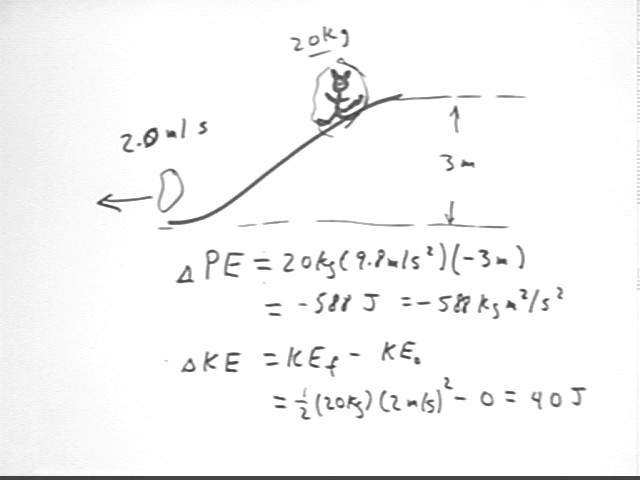
Physics I Quiz 1018
University and General Physics: A child of mass 20 kg slides from rest down a sliding board which is 3 meters high and reaches the bottom traveling at 2 m/s. How much thermal energy was generated by friction?
The potential energy of the child decreases as altitude decreases. The change in the child's PE is -588 Joules, which we note is equal to -588 kg m^2 / s^2.
The child's KE increases from 0 to 40 Joules.
Intuitively the PE decrease tends to increase KE (this is what tends to happen when things descend), which in the absence of nonconservative forces would therefore increase from 0 Joules to 588 Joules. However the KE increases only to 40 Joules, leaving 548 Joules of lost PE that go into something besides increased KE. In this case that 548 Joules is dissipated due to thermal energy.

The conservation of energy equation shows this. From `dPE = -588 J and `dKE = 40 J we easily conclude that `dWnoncons = 548 J. The statement of the problem implicitly assumes that the only nonconservative force is friction, so that 548 J is dissipated as thermal energy resulting from friction.
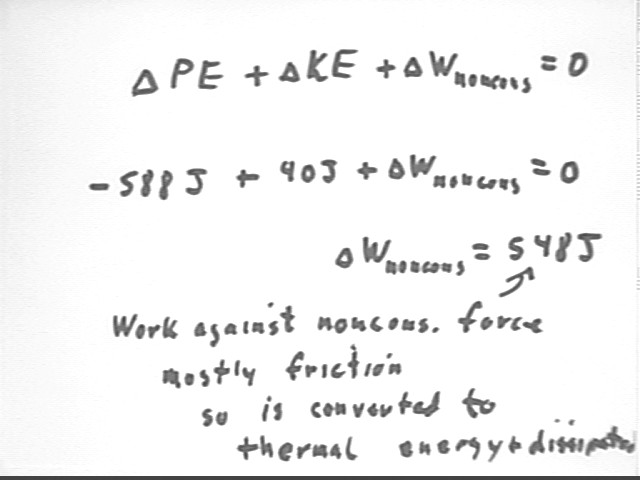
`dPE is the work done by the system against the conservative gravitational force. SInce the vertical displacement and the gravitational force are in the same direction gravity does positive work on the system so the system does negative work against gravity. It follows that the work done by the system against gravity is negative, which is why `dPE is negative.
Typical data from the rubber band experiment yields the following graph. A good writeup would also contain a table of the data from which this information was obtained.
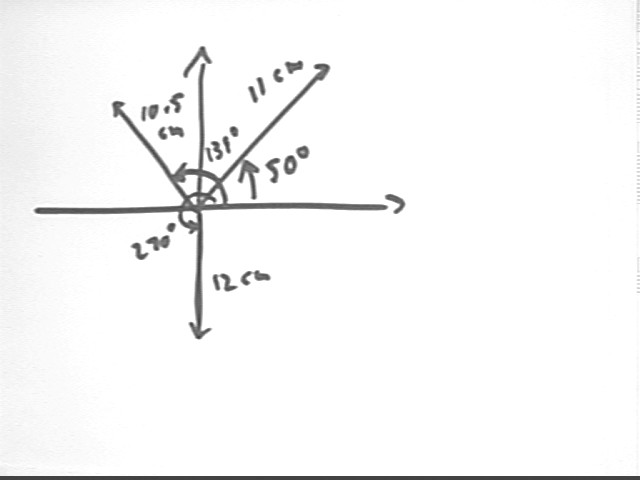
According to the tension vs. length information provided last time (tension = 1 N / cm * (length - 8 cm) ) we obtain the following forces. Note how forces are sketched approximately (but not really very well) to scale and do better. Note also that all force information is contained in one place, on one graph. In a good writeup there would also be a table showing these results and an explanation of how the forces and angles were provided:
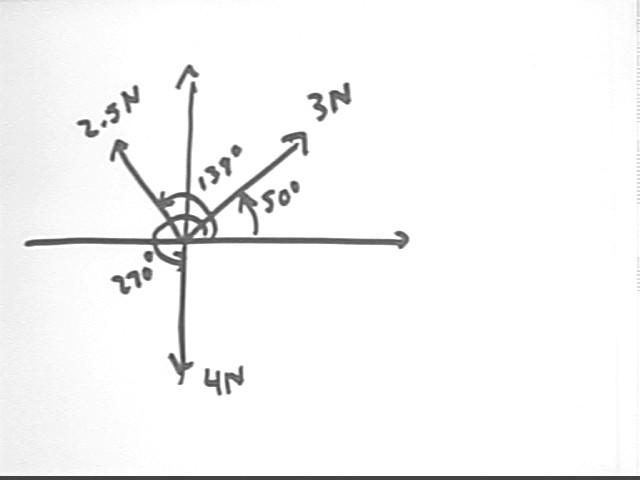
The forces are broken into x and y components. This information should be sketched and also presented in a table.
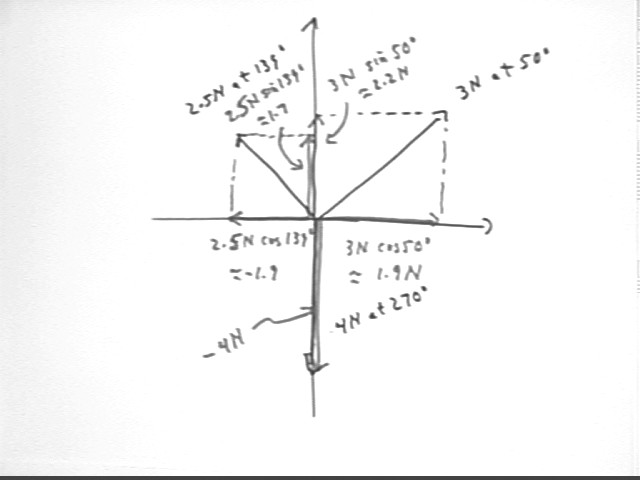
We note that the x components as given here add up to 0 and the y components to -.1 N. Since the system is stationary it is not accelerating, so that the net force at any point must be 0. These results are consistent, up to experimental error, with that expectation.
How much kinetic energy does it take to get a typical 1800-kg vehicle moving from rest to a typical freeway velocity of about 30 m/s? If a gallon of gasoline stores approximately 100 megaJoules of potential energy, about 15% of which an automobile engine can convert to useful energy, then how much gasoline fuel would it take to accelerate to freeway velocity?
By subtracting initial from final KE we see that the change in KE is .81 M J (M J stands for megaJoules, or millions of Joules).
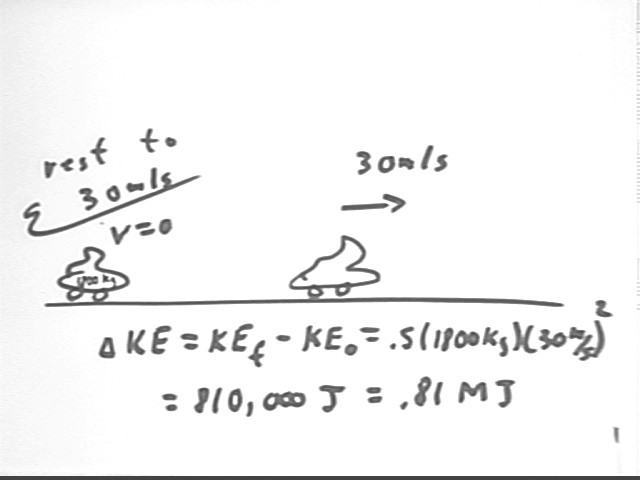
Thus the gasoline must provide .81 MJ of useful energy. Only 15% of the energy supplied is useful, so 15% of the total PE of the gasoline used must give us .81 MJ. This tells us that the PE lost by the gasoline must be .81 MJ / .15 = 5 MJ, approx..
Since there are 100 MJ in a gallon we need 5 MJ / (100 MJ / gal) = .05 gal of gasoline.
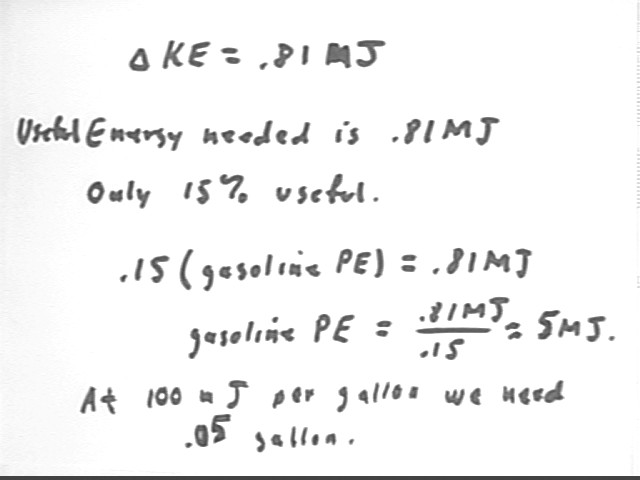
A mass of 45 grams is attached to a cart of mass 270 grams and suspended by a light string a-goin' over a pulley of negligible mass and friction. The cart is placed on a ramp whose slope is just enough to compensate for the small frictional force acting on the cart. When the system is released, what will be the acceleration of the cart?
The small picture at upper right in the figure below depicts the forces acting on the system. The weight of the cart is equivalent to its parallel and perpendicular components, the normal force balances the perpendicular weight component in order to prevent the collapse of the incline, and the frictional force is equal to the product of the coefficient of friction and the magnitude of the normal force. By the conditions stated in the problem the frictional force and the parallel component of the normal force are equal and opposite. The .44 N weight of the 45 gram mass acts downward on that mass.
The net force on the system is therefore .44 N. The total mass of the system is .315 kg so its acceleration is a = .44 N / (.315 kg) = 1.4 m/s^2, approx..
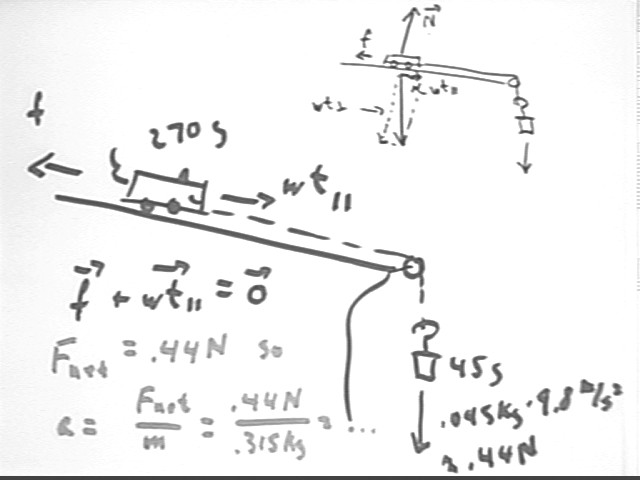
Suggested for next time:
All students: Sketch out how you would solve each problem.Problem Number 1
An engine drives a vehicle a distance of 4 meters.
A system consists of an object of mass 5 kg moving in the positive x direction at 25 m/s, and another of mass 21 kg moving at 28 m/s in the negative x direction. What is the total momentum of this system?
Problem Number 5An object of mass 6.7 kilograms is acted upon by a net force of 53.6 Newtons.
An object with mass 20 kilograms is initially at rest.
By how much does the velocity of an object of mass 13 Kg change under the following conditions:
What is the velocity of an object of mass 8 kg if its momentum is known to be 40 kg m/s?